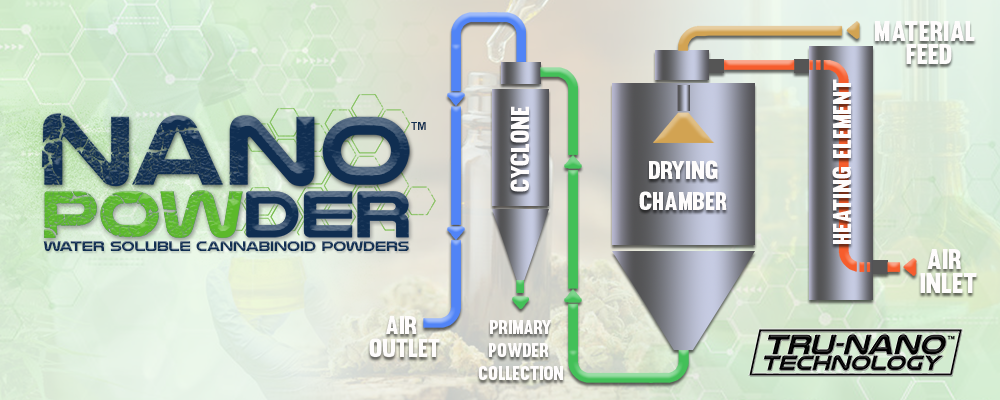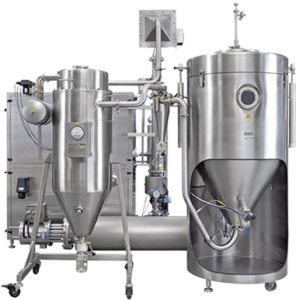
The Secret Sauce: Nano Emulsions
Nano emulsions are a type of emulsion, which is a mixture of two immiscible liquids (such as oil and water) stabilized by an emulsifying agent.
Increase the value of your raw materials with water solubility, increased bio-availability and maximized shelf life.
Spray dried powders are a type of dry powder that is produced by atomizing a liquid into small droplets and then rapidly drying them with hot air. The liquid, which can be a solution, suspension, or emulsion, is sprayed into a drying chamber, where it is exposed to a stream of hot air. The hot air evaporates the solvent, leaving behind tiny particles of dry powder. The resulting powder is free-flowing, easy to handle, and can be packaged for long-term storage.
Spray drying is a commonly used process in the food, pharmaceutical, and chemical industries. It is a fast and efficient way to produce powders with a uniform particle size and a high surface area. The powders produced by spray drying are often used as ingredients in other products, or as functional additives, such as flavorings, sweeteners, and active ingredients.
Spray drying has several advantages over other drying methods. It is capable of producing powders with a fine particle size and a uniform composition, which makes them easy to mix and dispense. It also allows for precise control of the final product properties, such as particle size, solubility, and surface area. Additionally, spray drying can preserve the stability and activity of heat-sensitive materials, making it a popular choice for the production of many food and pharmaceutical products.
Spray drying is a continuous process that involves the atomization of a liquid feed into small droplets, followed by rapid evaporation of the solvent to produce dry, free-flowing powder particles. The basic steps of spray drying include:
Feed preparation: The liquid feed, which can be a solution, suspension, or emulsion, is prepared and filtered to remove any impurities that may affect the quality of the final product.
Atomization: The liquid feed is atomized into small droplets using a spray nozzle or atomizer. The size and distribution of the droplets can be controlled to produce a uniform powder with the desired particle size.
Drying: The atomized droplets are introduced into a drying chamber, where they are exposed to a stream of hot air. The hot air evaporates the solvent, leaving behind tiny particles of dry powder.
Collection: The resulting powder is collected in a cyclone separator or a bag filter and then transferred to a storage container or packaged for shipping.
The efficiency of the spray drying process is influenced by several factors, including the properties of the feed, the design of the atomizer, the temperature and velocity of the drying air, and the operating conditions in the drying chamber. By controlling these factors, it is possible to produce powders with a wide range of properties, including particle size, surface area, solubility, and stability.
Late 19th century: Spray drying is first used to produce dried milk and other dairy products, laying the foundation for the commercialization of the process.
Early 20th century: Spray drying technology is further developed and refined, with the introduction of improved atomization techniques and the development of new drying chamber designs.
1950s-1960s: Spray drying becomes widely adopted in the food industry, with the introduction of new applications for producing coffee, tea, and other food ingredients.
1970s-1980s: Spray drying begins to be used in the pharmaceutical industry, as a means of producing dry powders for oral and inhaled drug delivery.
Late 20th century: The introduction of computer-controlled spray drying systems and the development of new atomization and drying technologies result in further improvements in the efficiency and versatility of the process.
Since then, spray drying has continued to evolve and expand into new areas of application, with ongoing research and development aimed at improving the efficiency and performance of the process. Today, spray drying is widely used across a range of industries and is recognized as an effective and efficient way to produce high-quality powders with controlled particle size, morphology, and other physical properties.


Nano emulsions are a type of emulsion, which is a mixture of two immiscible liquids (such as oil and water) stabilized by an emulsifying agent.

The history of spray drying can be traced back to the late 19th century, when the process was first used to produce dried milk and

The history of nanotechnology can be traced back to the late 1950s and early 1960s, when scientists first began to explore the properties and behavior